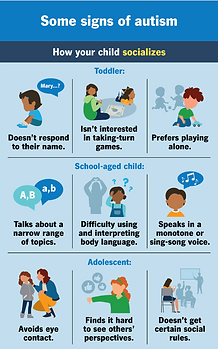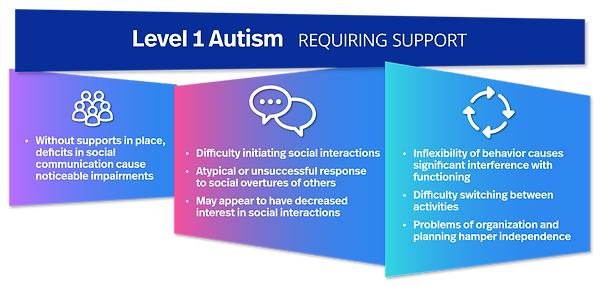Understanding Autism
Ananya Tanna
14th January 2025
What is Autism?
According to the Cleveland Clinic, autism is essentially a difference in how ones’ brain works and shapes how they interact with the world around them. An important thing to note is that autism is not something that is developed, but rather something a person is born with. Autism has nothing to do with parenting styles, foods, vaccines, or anything else your child encountered after birth. It is yet not known the cause for autism and more research is necessary in that field.
On the other hand, what is known is that Autism is not a disease–this is extremely important to note as people tend to “cure” diseases, which simply can’t be done with autism; instead, professionals try to find ways to help out individuals to allow them to identify and make the most out of their strengths while managing any challenges that they might face. Secondly, people with autism are neurodivergent. This typically can be defined as a word that describes people whose brains are different to what is ordinary; neurodivergent people may excel significantly in some topics, but may require more support in other areas. Thirdly, autism is a spectrum–by this it is meant that there is an extraordinarily wide range of personality traits, strengths, and challenges one might have when they have autism. Lastly, autism more often than not, misunderstood. For decades, people, including medical professionals, have said and done things that are now known as incorrect or even harmful towards autistic people. An example of this is in earlier times, the strict forms of behavioural therapy were used to get children to act and talk like their peers. Subsequently, today’s therapies allow children with autism and their families to gain skills without forcing kids to act a certain way
What is Autism Spectrum Disorder?
Autism Spectrum Disorder (ASD) can be defined as a collective group of early-appearing social deficits and sensory-motor behaviours that are associated with a very strong genetic contributing factor, along with several other causes1. As the name suggests, it is a disorder with varying severities, personality traits, strengths and challenges2, with some individuals requiring more support than others.
The outlook for many people with autism spectrum disorder is much more promising than what it was just 50 years prior. More and more people with this condition are able to speak, read, and live in the community rather than institutions, and some will be largely free from institutions; some will also be clear from symptoms of the disorder by adulthood. Nonetheless, most individuals affected by ASD still will not work independently or work full time–though there are exceptions.
According to Catherine Lord, genetics and neuroscience have identified interesting patterns of risk, though without much benefit in a practical point of view. A great amount of work is still necessary in order to understand how and when behavioural and medical treatments can be effective. In addition, it is extremely important to carry out what is already known as well as develop services for adults with autism spectrum disorder. Clinicians can make a notable difference by providing timely and individualised treatments and help to families in navigating recommendations and access to support systems, by providing accurate information despite the media input which is often unfiltered and inaccurate.
Based on the data collected in the United States of America in 2020, 1 in every 36 children are diagnosed with autism; this is approximately 3%. Autism seems to be becoming increasingly common, though this increase is likely due to healthcare providers having better knowledge and resources than what they had in the past.Thus, they are better able to understand and identify as well as support people with autism, which leads to more office visits along with diagnoses.
There are numerous characteristics, better known as symptoms, that healthcare providers look for when it comes to diagnosing autism and deciding the kind of support one needs. These “characteristics” are simply specific behaviors. There are numerous characteristics, and no two people share them. Implying that each person with autism is unique. Providers organise the characteristics into two categories:
-
Difficulties with social communication and interaction. This is what affects the way an individual interacts with new people
-
Restricted and repetitive behaviours, interests or activities. These affect how one acts.
Parents tend to look for signs that something is not right, for instance, a fever or swollen glands–but autism characteristics do not show signs of anything being wrong, rather they are signs of difference. Along with this, these are signs that an individual may need support to manage society’s expectations and demands, which are often designed for neurotypical people.
Signs in Children according to The Cleveland Clinic:


How your child socialises:
Socialising at the age of two is extremely different from socializing at the age of 5, 10 or even 15. How these difficulties look in your child can differ widely based on their age and numerous other factors; this includes other conditions they may have that affect their communication.
Toddlers might:
-
Not follow your gaze or things you are pointing to.
-
Not answer or respond to their name or when called.
-
Seem uninterested in playing taking-turn1 games.
-
Not share discoveries they have made.
-
Avoid making eye contact.
-
Use another person’s hand to pick up things they want.
-
Prefer to play by themselves.
Older children may:
-
Talk about a narrow range of topics
-
Have one sided conversations2
-
Seem uninterested in in starting a conversation
-
Have difficulty expressing their feelings or understanding how other people feel
-
Have difficulty understanding body language3
-
Speak in a monotone or “sing-song” voice.
-
Have difficulty noticing social cues
-
Adolescents3 might:
-
Have trouble with understanding what other people mean.4
-
Have difficulty mixing body language and spoken words
-
Have a hard time building relations with peers (i.e. making friends)
-
Get along better with little kids rather than adults or people their own age.
-
Find it difficult to see things in other peoples’ perspectives
-
Find social rules5 difficult to understand
-
Appear antisocial when around others
How your child behaves/acts:
Children may-
-
Repeat the same words or phrases
-
Repeat the same words/motions6
-
Become fixated on repetitive actions with a toy or part of a toy, like spinning the wheels of a toy car
-
Get angry with changes to their routine
-
Line toys up in a specific order and resist anyone changing it.
-
Won't eat certain foods with specific textures
-
Reacts strongly to certain fabrics or materials on their skin
-
Shows interest in an unexpected object such as a wooden spoon or fan.
Older Children or Adolescent may:
-
Repeat certain phrases or words–possibly from tv shows, books, and/or movies
-
Find difficulty in transitioning between tasks
-
Strongly prefer familiar routines or patterns or behaviour
-
Have intense or strongly focused interests
Keep in mind, the line between a child being autistic versus simply being a child is unclear. Many of the things mentioned above are true for all of the children at one point or another. In contrast, with autism, these behaviours may pose challenges for your child in certain settings, such as school, work, or socially.
Possible Causes of Autism
Researchers have yet not found a single cause of autism. It is likely a combination of genetics and certain factors related to pregnancy, labour and delivery.1 All of these aspects influence the brain differences that are seen in autism.
Specific things that may make autism more likely:
-
Becoming pregnant over the age of 35
-
Becoming pregnant within 12 months of having another baby
-
Having gestational diabetes
-
Bleeding during pregnancy
-
Using certain medication while pregnant.2
-
Smaller than expected fetal size.3
-
Reduced oxygen to the fetus during pregnancy or delivery.
-
Giving birth early
Autism and Genetics:
The genetic causes of autism are quite complex. There is no single or specific gene variation that is unique to autism. This essentially makes autism different from other genetic variations, for instance, Cystic Fibrosis–where medical professionals can pinpoint the specific variation(s) in the gene.
Contranstingly, numerous gene variations can be linked to autism. This means that people with autism may have one or more genetic variations that affect the differences in their brain. Not all individuals with autism have a clear genetic cause. Genetic testing for individuals may reveal no gene variations associated with autism whatsoever. Though, this does not change their diagnoses and it does not rule out any genetic causes. There is a possibility that other gene variations contribute to autism, and researchers simply have not identified them yet.
Furthermore, autism can in fact be inherited. Though, it is easy to confuse genetics with inheritance. When it is said that autism is genetic, it could also mean that variations in certain genes may affect how your baby’s brain works. Those gene variations could also come up for the first time in your baby–in case of that, it is likely not inherited. In opposition, it is possible for biological parents to pass down genetic variations to their children. Researchers also believe that autism can be inherited due to findings of patterns among siblings.
When it comes to autism, inheritance sometimes occurs in the form of genetic syndromes. There is a higher prevalence of autism in some genetic syndromes, such as fragile X syndrome, down syndrome, and tuberous sclerosis. With these syndromes, the individual has autism but is also affected by a wide range of developmental changes. Each syndrome is passed down through generations in specific ways–whether it’s through one or both biological parents.
Possible Causes of Autism
According to Autism Speaks, there are three levels to determine the severity of autism. The DSM-5 outlines three levels of severity for Autism Spectrum Disorder (ASD): Level 1 ("requiring support"), Level 2 ("requiring substantial support"), and Level 3 ("requiring very substantial support").
Level 3: “Requiring very substantial support”

Level 2: “Requiring substantial support"

Level 1: “Requiring support

Bibliography
1. Lord, Catherine, et al. “Autism Spectrum Disorder.” The Lancet, vol. 392, no. 10146, 1 Aug. 2018, pp. 508–520, www.thelancet.com/journals/lancet/article/PIIS0140-6736(18)31129-2/abstract?from=groupmessage&isappinstalled=0, https://doi.org/10.1016/s0140-6736(18)31129-2. Accessed 14 Jan. 2025.
2. Clinic, Cleveland. “Autism Spectrum Disorder (ASD) Symptoms & Causes.” Cleveland Clinic, Sept. 2023, my.clevelandclinic.org/health/articles/autism. Accessed 14 Jan. 2025.
3. Marketing. “When Did Autism Become a Diagnosis? | Oxford CBT.” Oxford CBT, 25 Sept. 2023, www.oxfordcbt.co.uk/when-did-autism-become-a-diagnosis/#:~:text=Building%20upon%20Kanner%27s%20foundational%20work,symptoms%20and%20levels%20of%20severity. Accessed 14 Jan. 2025.
4. “Autism Spectrum Disorder.” National Institute of Mental Health (NIMH), 2025, www.nimh.nih.gov/health/topics/autism-spectrum-disorders-asd. Accessed 14 Jan. 2025.
5. “ASD Levels of Severity | Autism Speaks.” Autism Speaks, 2024, www.autismspeaks.org/levels-of-autism. Accessed 14 Jan. 2025.